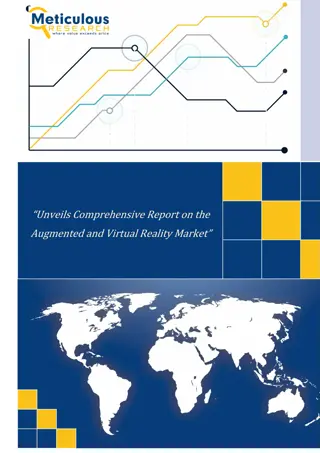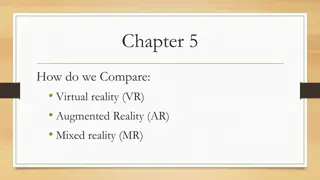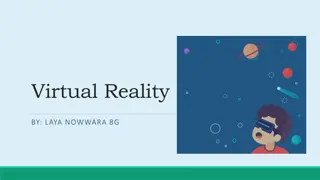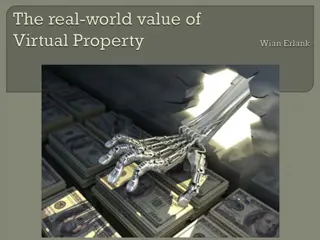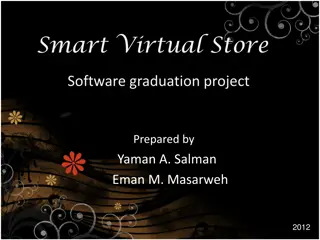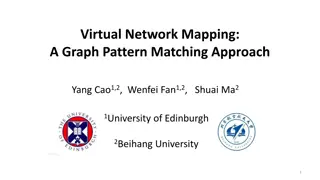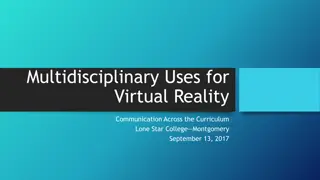Virtual Reality Software System at University of Illinois
The Virtual Reality Software System at University of Illinois leverages a Virtual World Generator to create alternative realities using synthetic models or real-world data. Tasks for the Virtual World Generator involve matched motion and user locomotion, while dealing with challenges like collision detection and networked experiences. Developer choices for Virtual World Generators include Unity with C#, Unreal with C++, and A-Frame/WebVR with JavaScript and HTML. Perceptual psychology in VR explores how the brain processes sensory input to create perceived phenomena.
- Virtual Reality
- University of Illinois
- Software System
- Virtual World Generator
- Perceptual Psychology
Download Presentation

Please find below an Image/Link to download the presentation.
The content on the website is provided AS IS for your information and personal use only. It may not be sold, licensed, or shared on other websites without obtaining consent from the author. Download presentation by click this link. If you encounter any issues during the download, it is possible that the publisher has removed the file from their server.
E N D
Presentation Transcript
VR Software CS 498 VR UNIVERSITY OF ILLINOIS AT URBANA-CHAMPAIGN
VR System: Software Our conception of a VR software system will rely on Virtual World Generator (VWG) to generate an alternative reality This alternative world can be totally synthetic or based on data captured from the real-world or a combination. 3D images from synthetic models are generated using computer graphics techniques Real-world data can be capture using cameras (often specialized) Combining both is often referred as augmented reality or mixed-reality. Augmented reality often has the connotation of being a real-time operation.
VWG Tasks 1. Matched Motion A matched zone is a safe region in which a correspondence is maintained between the user motion in the real and virtual world. The safe region must be free from dangers in the real world. The VWG must alter the virtual world in concert with user movements. Types of self motion: 2. User Locomotion Often, it is necessary to provide a mechanism for non-matched motion that allows the user to move through the virtual and explore it. Examples include navigating via mini-map or using a ______________________________________________________________ __ game controller to move through world. This type of motion can lead to motion-sickness. ______________________________________________________________ __
VWG Tasks What makes collision detection hard? Can anyone suggest some reasons? 3. Physics The VWG typically provides some approximation of real-world physics (e.g. collision detection and resolution). This is a surprisingly complicated task 4. Networked Experiences Types of self motion: The VWG must maintain coherence in shared worlds. One user s actions must be seen throughout the shared world and interactions must be handled in a realistic manner. ______________________________________________________________ __ ______________________________________________________________ __
Developer Choices for VWGs Unity ( using C#) recommended You will use it for the MPs & lots of support available on/off campus Unreal ( using C++) A-Frame/WebVR (uses JavaScript and HTML) ...I wouldn t recommend trying to build an application from lower level tools like WebGL or DirectX someone tell me why
Sensation and Perception CS 498 VR UNIVERSITY OF ILLINOIS AT URBANA-CHAMPAIGN
Perceptual Psychology Perceptual psychology seeks to understand how the brain converts sensory stimulation into perceived phenomena. Here are some typical questions that arise in VR and fall under this umbrella: How far away does that object appear to be? How much video resolution is needed to avoid seeing pixels? How many frames per second are enough to perceive motion as continuous? Is the user s head appearing at the proper height in the virtual world? Where is that virtual sound coming from? Why am I feeling nauseated? Why is one experience more tiring than another? What is presence?
Human Senses People often believe their senses produce very accurate data about reality This is not really true .
Optical Illusions Ponzo Illusion
lecture4 video 1- NeuronsFiring.mp4 Neural Processing Cerebral Cortex Only found in mammals Handle perception, memory, language Sheet of neurons 3mm thick, heavily folded Neurons firing https://www.youtube.com/watch?v=kQxsTyNKtqg https://en.wikipedia.org/wiki/List_of_animals_by_number_of_neurons
Neural Processing September 2018 .
Neural Processing Neuron count is not the only attribute that matters It is an over-simplified model but you can consider neurons a directed graph Dendrites are input edges Axons are output edges Lots of branching very unconstrained structure Synapse is the space between a dendrite-axon pair About 7000 synaptic connections per neuron 1015 edges
Hierarchical Processing Signals from multiple receptors are combined And then combined with signals based on life experience
Proprioception Proprioception is the ability to sense the relative positions of parts of our bodies .and the amount of muscular effort being involved in moving them. Motor cortex sends efference copies to other parts of brain Communicates what motions have happened. it why you can t tickle yourself .
Fusion of Senses So perception typically involves multiple sensory inputs plus experience Processing gets wacky* when an input is present without others usually present Can cause Fatigue Headaches Nausea *wacky technical term indicating that something is not typical or normal
Vection Vection is the sensation of movement of the body in space produced purely by visual stimulation.
Adaptation Perceptually, adaptation means the perceived effect of stimuli changes over time Perceived loudness of noises decreases in minutes Our vision rapidly adapts to changes in light Anecdotally, gaming with FPS games all the time leads to less nausea Can be useful in debugging you can train to perceive things such as A large amount of tracking latency has appeared The left and right eye views are swapped. Objects appear to one eye but not the other. One eye view has significantly more latency than the other. Straight lines are slightly curved due to uncorrected warping in the optical system
Psychophysics Psychophysicsis the scientific study of perceptual phenomena that are produced by physical stimuli. Example: Under what conditions is a light perceived as red? Experiment: Vary frequency of a mono-chromatic light until people call it red.
Stevens Power Law Stevens power law, characterizes the relationship between the magnitude of stimulus and perceived magnitude It suggests ? = ??? Where m is the magnitude or intensity of the stimulus, p is the perceived magnitude, x relates the actual magnitude to the perceived magnitude c is an uninteresting constant that depends on units.
Just Noticeable Difference (JND) JND is the amount of stimulus that needs to be changed so that subjects perceive it to have changed in at least 50% of trials JND can vary as stimulus magnitude vary, but the relationship will be: ? m= ? Where m is the magnitude and c is a constant. This is known as Weber s law.
Design of Experiments is very difficult How many subjects are enough? How do you measure adaptation to the experiment? How do you control for prior experience? What did the subjects eat for breakfast? Is your data gathered via questionnaire? Will they answer honestly? Can you make inferences about perception from other data? heart rate etc . This doesn t mean it shouldn t be done. It means it should be done as carefully as possible and with great effort.
Case Study: Depth Perception How do we perceive how far away an object is? Classic example of sensory fusion. What are some of the multiple data we use to perceive depth?
Binocular Cues Convergence Stereoscopic disparity / Binocular disparity Shadow Stereopsis
Monocular Cues Relative Size Absolute Size and Familiar Size Elevation Texture Gradient Motion Parallax (demo)
Monocular Cues Aerial Perspective (distance fog) Linear Perspective Overlap (or Interposition) (demo) Shading and Lighting Accommodation
Stimuli Hierarchical Processing lecture4 video5 - T-rex Illusion.mp4 https://youtu.be/A4QcyW-qTUg
Stimuli Fusion: Balance + Vision lecture4 video2 - Vection in background of video movement.mp4 Vection Why is this important? https://youtu.be/RbOQFIo3g44 lecture4 video3 - vestibuloocular reflex.mp4 Vestibulo-ocular reflex (VOR) Why is this important? Perception of stationarity https://youtu.be/mlbyNq8KedQ
How Does Our Brain Piece Images Together? lecture4 video 4- inverted vision 1.mp4 lecture4 video 5- pupil tracking.mp4 https://youtu.be/MHMvEMy7B9k https://youtu.be/2NcUkvIX6no https://youtu.be/eR2j-fh18mk https://youtu.be/3_dm7jSX4Cw lecture4 video 6- football eye track.mp4 lecture4 video 7- eye tracking in vr.mp4
Stimuli Fusion: Speech Processing lecture4 video 8- McGurk.mp4 https://www.youtube.com/watch?v=G-lN8vWm3m0 (0:32-2:30)
First Homework Assignment! Machine Problem (MP) 1 is released! See course website under Assignments tab. You must work with a partner; find a buddy on Piazza MP s are submitted on Compass. Only one of the partners should submit the zip file to us. Be sure to name it with both NetID s so we know who it s for. Other policies to know regarding assignments on course website (late submissions, etc) Lavalle, CH 2.3 & 3





